Let's go on a walk through the merchant streets of Verkhneudinsk.
Ulan-Ude is one of the few Russian cities that have preserved most of their historical buildings. The Arbat, Gostynye Ryady, Kommunisticheskaya St., Sobornaya St., Banzarova St. and Sverdlova St. - wherever you go, you'll always run into stone and wooden houses that used to belong to merchants and peasants, doctors and traders. In this article we will briefly teleport into the 19th century: we will walk along the streets of Verkhneudinsk and peek into trading stalls, admire merchant manors and examine platbands. *The "Old Town" project, which is aimed at preserving cultural heritage sites and providing assistance to the owners of the facilities.Learn more about the project at старыйгород03.рф
Ulan-Ude is one of the few Russian cities that have preserved most of their historical buildings. The Arbat, Gostynye Ryady, Kommunisticheskaya St., Sobornaya St., Banzarova St. and Sverdlova St. - wherever you go, you'll always run into stone and wooden houses that used to belong to merchants and peasants, doctors and traders. In this article we will briefly teleport into the 19th century: we will walk along the streets of Verkhneudinsk and peek into trading stalls, admire merchant manors and examine platbands. *The "Old Town" project, which is aimed at preserving cultural heritage sites and providing assistance to the owners of the facilities.Learn more about the project at старыйгород03.рф
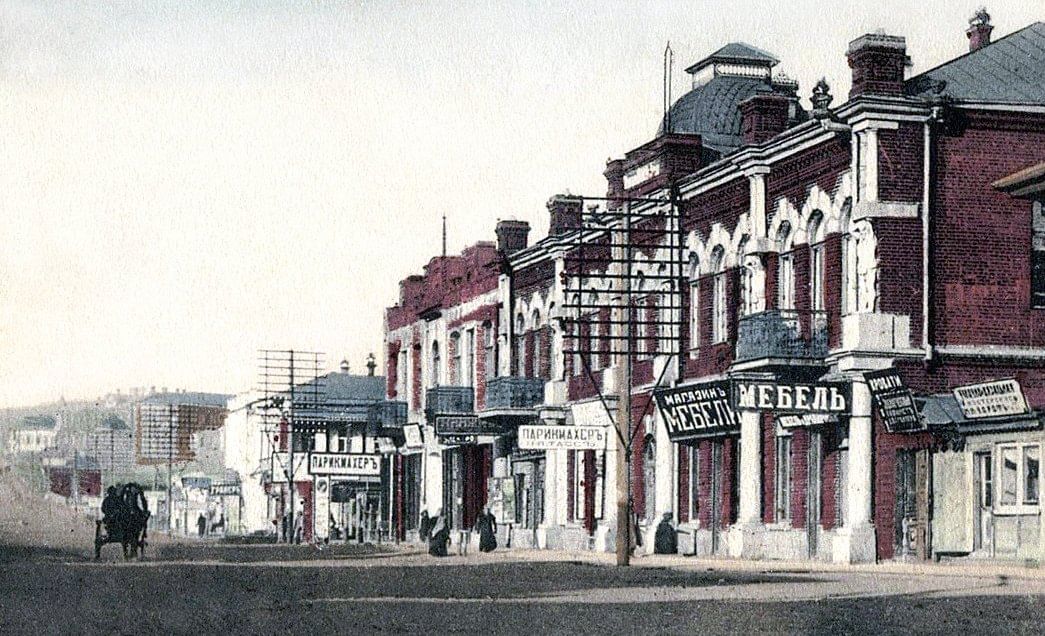
From a winter camp to a trading town
The city's history starts in 1666, when a group of Cossacks built a small winter cabin on the Uda bank. Several years later, the cabin grew into the Udinsky ostrog that had about a hundred houses, a gunpowder warehouse and a chapel. 50 years later the town was named Verkhneudinsk. In 1991, a memorial sign was placed on the site of the ostrog to commemorate the founding of the city, and later ruins of the winter camp palisade, coins and fragments of pottery were unearthed during an archeological excavation. For many years, the city's main occupation was trade. Many wealthy merchants lived in Verkhneudinsk. In many preserved buildings, one room was generally used as a trading stall. A good example of such architecture is the Stall House at 18, Kuibysheva St. that belonged to the rich merchant and honored citizen Mitrofan Kurbatov. The first floor was rented out for shops, whereas the second floor was residential. Attractive columns were made out of whole larches and initially had an arched driveway between each other for access to the courtyard. Today, the house has been expanded and is currently occupied by an injury care center of a local municipal clinic.
In front of the house lies the oldest square of the city. Now it's called Revolutsii Square, but previously it was called Bazarnaya Square. Everyone in Siberia knew about the Verkhneudinsk fair that took place twice a year, in January and in autumn. You could find everything here, from flour to fish, from nuts to expensive furs. In early 19th century, merchants and the rich bourgeois decided to build here the stone Gostyny Dvor. Its construction in stages lasted 60 long years. Now the building is considered a prime example of the early 19th century Russian Neoclassical merchant style and the centerpiece of the city's historical center.
In late 19th century, Alexandrovsky garden was founded not far from Gostynye Ryady, beyween a public well and a chapel. It was one of the most beloved places for recreation among the townsfolk. An ice rink would be set up here in winter, and wind orchestra would perform here during the January fair. Nowadays, the public well building houses the Tam, Gde Restaurant, the chapel, destroyed during the Soviet era, has now been rebuilt, and the Alexandrovsky garden is still a great place to slowly walk around or rest on a bench under the tree shade. One of the founders of Verkhneudinsk (now Ulan-Ude) was Gavrila Lovtsov, a pyatidesyatnik.
The city's history starts in 1666, when a group of Cossacks built a small winter cabin on the Uda bank. Several years later, the cabin grew into the Udinsky ostrog that had about a hundred houses, a gunpowder warehouse and a chapel. 50 years later the town was named Verkhneudinsk. In 1991, a memorial sign was placed on the site of the ostrog to commemorate the founding of the city, and later ruins of the winter camp palisade, coins and fragments of pottery were unearthed during an archeological excavation. For many years, the city's main occupation was trade. Many wealthy merchants lived in Verkhneudinsk. In many preserved buildings, one room was generally used as a trading stall. A good example of such architecture is the Stall House at 18, Kuibysheva St. that belonged to the rich merchant and honored citizen Mitrofan Kurbatov. The first floor was rented out for shops, whereas the second floor was residential. Attractive columns were made out of whole larches and initially had an arched driveway between each other for access to the courtyard. Today, the house has been expanded and is currently occupied by an injury care center of a local municipal clinic.
In front of the house lies the oldest square of the city. Now it's called Revolutsii Square, but previously it was called Bazarnaya Square. Everyone in Siberia knew about the Verkhneudinsk fair that took place twice a year, in January and in autumn. You could find everything here, from flour to fish, from nuts to expensive furs. In early 19th century, merchants and the rich bourgeois decided to build here the stone Gostyny Dvor. Its construction in stages lasted 60 long years. Now the building is considered a prime example of the early 19th century Russian Neoclassical merchant style and the centerpiece of the city's historical center.
In late 19th century, Alexandrovsky garden was founded not far from Gostynye Ryady, beyween a public well and a chapel. It was one of the most beloved places for recreation among the townsfolk. An ice rink would be set up here in winter, and wind orchestra would perform here during the January fair. Nowadays, the public well building houses the Tam, Gde Restaurant, the chapel, destroyed during the Soviet era, has now been rebuilt, and the Alexandrovsky garden is still a great place to slowly walk around or rest on a bench under the tree shade. One of the founders of Verkhneudinsk (now Ulan-Ude) was Gavrila Lovtsov, a pyatidesyatnik.
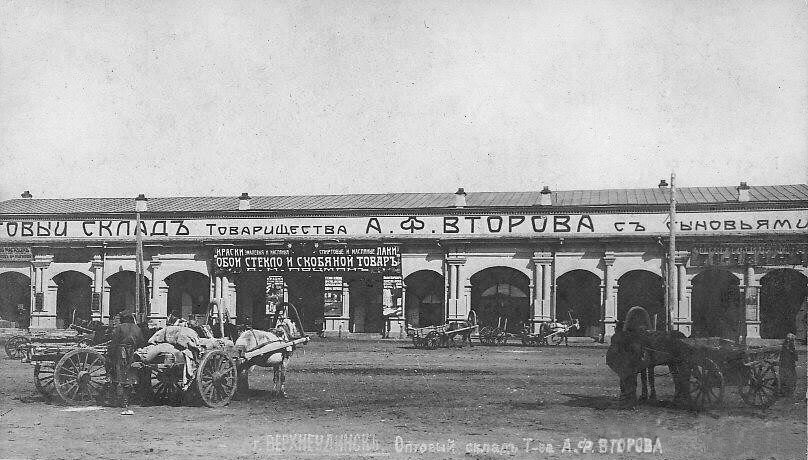
Along Sobornaya St. and Losevskaya
St. Sobornaya St. - one of the oldest in the city - was built in late 17th century. It was the city's central street for many years. In addition to administrative buildings, such as a post office, a police department, a district Cossacks' station, a poorhouse and a pharmacy, it also had houses that belonged to merchants, clergymen, peasants and the Cossacks. Nowadays, Sobornaya St. is a pedestrian street. The buildings here have been restored, and some of them are still residential, while others have cafés or shops. For example, a restaurant with a merchant menu was opened in the house of the merchant Skrylnikova (8 Sobornaya Street), and the Traditional Asian Medicine Center is located nearby (10 Sobornaya Street). Not far from here is the first private museum in Ulan-Ude, the Lev Bardamov Gallery, which collects ancient maps, household items of Verkhneudinsk residents and rare books.
Another old street crosses Sobornaya St.: Kommunisticheskaya St. (previously Losevskaya St.). There used to be merchant manors, tenement buildings, hotels, a pharmacy and shops here. Some of the buildings survived to this day. For example, the building of the former Verkhneudinsky district school (16, Kommunisticheskaya St.), which was the first educational institution in the city. Dmitry Davydov, a staff superintendent of district schools and also the writer of the Glorious Sea, Sacred Baikal song, used to live and work here.
A nearby street - Sverdlova St., previously Sennaya St. - also partially preserved its prerevolutionary spirit. One of the oldest buildings here is the Verkhneudinsk synagogue. It is believed that members of the city's Jewish community used to live on this street. Now, the synagogue building acts as an education building of the ESSUTM construction faculty. The facade ornaments and details have not survived to this day.
A restaurant with a merchant menu was opened in the house of the merchant Skrylnikova (8 Sobornaya Street).
St. Sobornaya St. - one of the oldest in the city - was built in late 17th century. It was the city's central street for many years. In addition to administrative buildings, such as a post office, a police department, a district Cossacks' station, a poorhouse and a pharmacy, it also had houses that belonged to merchants, clergymen, peasants and the Cossacks. Nowadays, Sobornaya St. is a pedestrian street. The buildings here have been restored, and some of them are still residential, while others have cafés or shops. For example, a restaurant with a merchant menu was opened in the house of the merchant Skrylnikova (8 Sobornaya Street), and the Traditional Asian Medicine Center is located nearby (10 Sobornaya Street). Not far from here is the first private museum in Ulan-Ude, the Lev Bardamov Gallery, which collects ancient maps, household items of Verkhneudinsk residents and rare books.
Another old street crosses Sobornaya St.: Kommunisticheskaya St. (previously Losevskaya St.). There used to be merchant manors, tenement buildings, hotels, a pharmacy and shops here. Some of the buildings survived to this day. For example, the building of the former Verkhneudinsky district school (16, Kommunisticheskaya St.), which was the first educational institution in the city. Dmitry Davydov, a staff superintendent of district schools and also the writer of the Glorious Sea, Sacred Baikal song, used to live and work here.
A nearby street - Sverdlova St., previously Sennaya St. - also partially preserved its prerevolutionary spirit. One of the oldest buildings here is the Verkhneudinsk synagogue. It is believed that members of the city's Jewish community used to live on this street. Now, the synagogue building acts as an education building of the ESSUTM construction faculty. The facade ornaments and details have not survived to this day.
A restaurant with a merchant menu was opened in the house of the merchant Skrylnikova (8 Sobornaya Street).

Precious wooden carvings
Sverdlova St., Kommunisticheskaya St. and Banzarova St. have the most wooden houses built in the 19th-early 20th century that survived to this day. They have similar layout, but the main value and charm of these houses is that they have retained unique facade decorations — platbands and cornices. Photographer, researcher and creator of the virtual museum of Russian platbands Ivan Khafizov says that windows with a similar structure consisting of shutters with a simple lower part and a richly decorated upper part can be found only in Ulan-Ude. Patterned cornices, or friezes, that are gable drops separating the log hut from the attic are another distinctive feature of the houses of Verkhneudinsk, rarely found in other cities. It is difficult to imagine how many hours the craftsmen worked to manually saw out the carved parts and creat wooden lace. Each part of the platband has its own meaning, not only practical, but also symbolic. The shutters were closed in cold weather for warmth and in hot weather for coolness. Head moulding, or lintel, is the upper part of the platband. It protected the window from rain and snow, like eyelids protect the eyes. On the windows of Verkhneudinsk houses, it is the lintel that stands out for its decoration. If you look closely, you can distinguish individual decorative elements. Sometimes the details carried a symbolic meaning — such as images of the sun and flowers, animals and birds; sometimes they reflected nationality or faith of the carver — elements of a traditional Buryat ornament or a David six-pointed Star can be found; and, perhaps, they even showed the hobbies of the house keepers: for example, ardent theatergoers could be identified by the relief decoration in the form of heavy curtains.
While walking, it is especially worth paying attention to the platbands near the house at 7a Sobornaya Street — here the frames are decorated with unusual birds with human heads, each of them has its own facial expression. Birds are also depicted on the platbands of the house at 18 Sobornaya Street, although they are more traditional and look like owls. The windows of the house at 15 Banzarov Street resemble grandma’s lace doilies since the cornices and platbands are skillfully carved. The house at 10 Sverdlov Street also preserved carved decorations on the windows and even miniature vases on the lintel tops. But the house fascinates passers-by with its unusual masonry arch and wooden gates, which are now under restoration.
Sverdlova St., Kommunisticheskaya St. and Banzarova St. have the most wooden houses built in the 19th-early 20th century that survived to this day. They have similar layout, but the main value and charm of these houses is that they have retained unique facade decorations — platbands and cornices. Photographer, researcher and creator of the virtual museum of Russian platbands Ivan Khafizov says that windows with a similar structure consisting of shutters with a simple lower part and a richly decorated upper part can be found only in Ulan-Ude. Patterned cornices, or friezes, that are gable drops separating the log hut from the attic are another distinctive feature of the houses of Verkhneudinsk, rarely found in other cities. It is difficult to imagine how many hours the craftsmen worked to manually saw out the carved parts and creat wooden lace. Each part of the platband has its own meaning, not only practical, but also symbolic. The shutters were closed in cold weather for warmth and in hot weather for coolness. Head moulding, or lintel, is the upper part of the platband. It protected the window from rain and snow, like eyelids protect the eyes. On the windows of Verkhneudinsk houses, it is the lintel that stands out for its decoration. If you look closely, you can distinguish individual decorative elements. Sometimes the details carried a symbolic meaning — such as images of the sun and flowers, animals and birds; sometimes they reflected nationality or faith of the carver — elements of a traditional Buryat ornament or a David six-pointed Star can be found; and, perhaps, they even showed the hobbies of the house keepers: for example, ardent theatergoers could be identified by the relief decoration in the form of heavy curtains.
While walking, it is especially worth paying attention to the platbands near the house at 7a Sobornaya Street — here the frames are decorated with unusual birds with human heads, each of them has its own facial expression. Birds are also depicted on the platbands of the house at 18 Sobornaya Street, although they are more traditional and look like owls. The windows of the house at 15 Banzarov Street resemble grandma’s lace doilies since the cornices and platbands are skillfully carved. The house at 10 Sverdlov Street also preserved carved decorations on the windows and even miniature vases on the lintel tops. But the house fascinates passers-by with its unusual masonry arch and wooden gates, which are now under restoration.
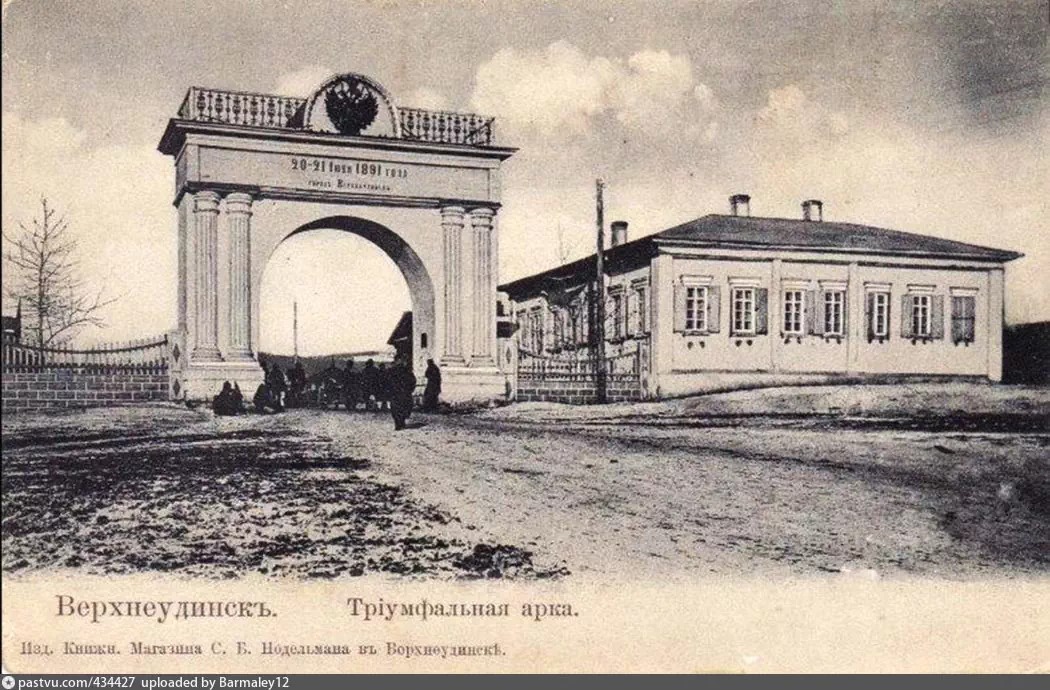
An ancient and cathedral city
St. Odigitrievsky Cathedral towers majestically over an old city. It is thanks to it that Sobornaya Street has such a name — it connected the Cathedral with the Spasskaya Church, which has not survived to the present day. Construction of the Cathedral lasted for 44 years. The first stone building with richly decorated windows and gilded carved iconostases located in the city is considered a Siberian Baroque architectural monument. On the other bank of the Uda River you can see the Church of the Ascension. Built at the end of the XVIII century it was originally located near the Udinsky Fort, under the Batareinaya Mountain. Later it was transported to the Zaudinsky Suburb — the Verkhneudinsk Cossack village. People were floating across Uda River on boats and longboats for a long time. For some time, the first “floating bridge” connected the banks, and in 1906 a wooden bridge was built, which was repeatedly strengthened and rebuilt. The modern bridge appeared only 90 years later.
The main street of the modern Ulan-Ude was built from the Odigitrievsky Cathedral — at different times it was called Bolshaya, Bolshaya Nikolaevskaya, Traktovaya, and now it is called Lenin Street. It led to Nagornaya Square, where a five-domed temple for 700 people was planned to be built. The plans did not come true, but in the 30s of the ХХ century, Nagornaya would change its name and become the main square of the city called the Square of Soviets.
St. Odigitrievsky Cathedral towers majestically over an old city. It is thanks to it that Sobornaya Street has such a name — it connected the Cathedral with the Spasskaya Church, which has not survived to the present day. Construction of the Cathedral lasted for 44 years. The first stone building with richly decorated windows and gilded carved iconostases located in the city is considered a Siberian Baroque architectural monument. On the other bank of the Uda River you can see the Church of the Ascension. Built at the end of the XVIII century it was originally located near the Udinsky Fort, under the Batareinaya Mountain. Later it was transported to the Zaudinsky Suburb — the Verkhneudinsk Cossack village. People were floating across Uda River on boats and longboats for a long time. For some time, the first “floating bridge” connected the banks, and in 1906 a wooden bridge was built, which was repeatedly strengthened and rebuilt. The modern bridge appeared only 90 years later.
The main street of the modern Ulan-Ude was built from the Odigitrievsky Cathedral — at different times it was called Bolshaya, Bolshaya Nikolaevskaya, Traktovaya, and now it is called Lenin Street. It led to Nagornaya Square, where a five-domed temple for 700 people was planned to be built. The plans did not come true, but in the 30s of the ХХ century, Nagornaya would change its name and become the main square of the city called the Square of Soviets.
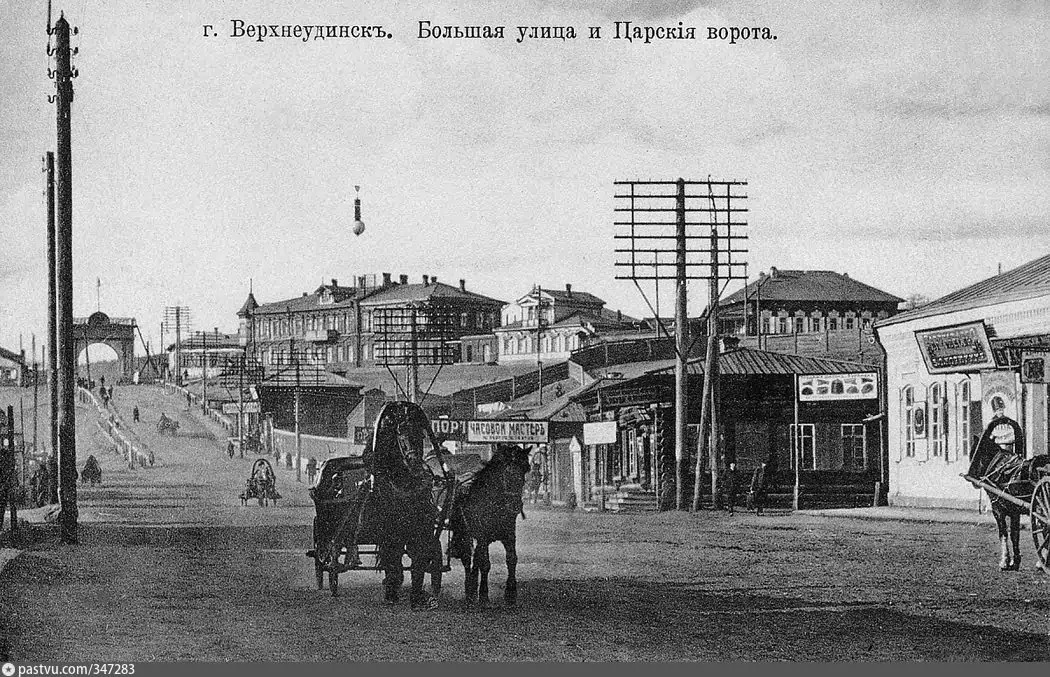
Merchant stories of Bolshaya Street
The Bolshaya Street was built up with houses of strictly similar height located on both sides. At the end of the XIX and beginning of the XX centuries, there were manors of residents of all classes: merchants, bourgeois, peasants, Cossacks, and clergy. Some of the buildings have been lost, but many merchant houses have survived to the present day. Part of the street that became a pedestrian area is unofficially called Arbat. One of the most striking surviving buildings is the Kapelman House at 30a Lenin Street. Bourgeois Naftoly Kapelman leased the ground floor for retail space, and the second floor as apartments for wealthy residents. Red brick walls, contrasting white sculptures of Atlanteans and huge windows - this house attracts the eye even now, a hundred years after its construction. At various times, the building was housed by a 24-hour dentist's office (they say that a dental technician specially invited from Moscow worked there, who inserted artificial teeth), a tea shop of Xing Tai Lun, a sweet shop "Modern" and I.E. Tsygalnitskiy coffeehouse.
Nearby, at 26a Lenin Street, there is another house with history — the house of the hereditary honorary citizen of Verkhneudinsk, Irkutsk merchant, gold miner, philanthropist Ivan Goldobin. In addition to household outbuildings, there were a vodka distillery with a basement and a stone annex on the manor territory, but they have not survived to the present day. The Ulan-Ude History Museum is now located in the main house of the manor.
In 1891, the Goldobins' house became the place where the future Emperor of Russia Nicholas II stayed for one night. The Arc de Triomphe, which can be seen up the Lenin Street, is dedicated to his arrival. Next to the arch there is another building associated with the Goldobin family. In the house at 50 Lenin Street there was a shelter for prisoners' children. It was created for children entering the Verkhneudinsk prison castle with their parents in order to protect them “from the influence of prisons at a very tender age.” The shelter existed with money from lotteries, performances, and donations from merchants. And Ivan Goldobin’s wife, Elena, was a member of the board of trustees.
Oriental silks, satin and cashmere, as well as ready-made dresses and Warsaw shoes could be bought in the "A.F. Vtorov and Sons" shopping precinct, which was located in a house at 21 Lenin Street at the beginning of the ХХ century. Irkutsk merchant Alexander Vtorov was considered the largest merchant of textile goods in Siberia and owned shops in Verkhneudinsk, Tomsk, and Chita. Previously, fashionistas of the city dressed here, and now the building houses the Provence cafe, the Trista Barista coffee shop, the Polinom bookstore, and other shops.
The “Goods for Women” shop is now located in the house of the Verkhneudinsk sergeant, Inokkenty Menshikov. However, in the ХХ century the building had a completely different life. The illusion cinema “Don Othello”, owned by the Italian Bataky, operated here. Later, the building housed a Red Cross infirmary, and then the first laundry room “Hygiene” opened here, where you could have your linen laundered and ironed at reasonable prices.
The Bolshaya Street was built up with houses of strictly similar height located on both sides. At the end of the XIX and beginning of the XX centuries, there were manors of residents of all classes: merchants, bourgeois, peasants, Cossacks, and clergy. Some of the buildings have been lost, but many merchant houses have survived to the present day. Part of the street that became a pedestrian area is unofficially called Arbat. One of the most striking surviving buildings is the Kapelman House at 30a Lenin Street. Bourgeois Naftoly Kapelman leased the ground floor for retail space, and the second floor as apartments for wealthy residents. Red brick walls, contrasting white sculptures of Atlanteans and huge windows - this house attracts the eye even now, a hundred years after its construction. At various times, the building was housed by a 24-hour dentist's office (they say that a dental technician specially invited from Moscow worked there, who inserted artificial teeth), a tea shop of Xing Tai Lun, a sweet shop "Modern" and I.E. Tsygalnitskiy coffeehouse.
Nearby, at 26a Lenin Street, there is another house with history — the house of the hereditary honorary citizen of Verkhneudinsk, Irkutsk merchant, gold miner, philanthropist Ivan Goldobin. In addition to household outbuildings, there were a vodka distillery with a basement and a stone annex on the manor territory, but they have not survived to the present day. The Ulan-Ude History Museum is now located in the main house of the manor.
In 1891, the Goldobins' house became the place where the future Emperor of Russia Nicholas II stayed for one night. The Arc de Triomphe, which can be seen up the Lenin Street, is dedicated to his arrival. Next to the arch there is another building associated with the Goldobin family. In the house at 50 Lenin Street there was a shelter for prisoners' children. It was created for children entering the Verkhneudinsk prison castle with their parents in order to protect them “from the influence of prisons at a very tender age.” The shelter existed with money from lotteries, performances, and donations from merchants. And Ivan Goldobin’s wife, Elena, was a member of the board of trustees.
Oriental silks, satin and cashmere, as well as ready-made dresses and Warsaw shoes could be bought in the "A.F. Vtorov and Sons" shopping precinct, which was located in a house at 21 Lenin Street at the beginning of the ХХ century. Irkutsk merchant Alexander Vtorov was considered the largest merchant of textile goods in Siberia and owned shops in Verkhneudinsk, Tomsk, and Chita. Previously, fashionistas of the city dressed here, and now the building houses the Provence cafe, the Trista Barista coffee shop, the Polinom bookstore, and other shops.
The “Goods for Women” shop is now located in the house of the Verkhneudinsk sergeant, Inokkenty Menshikov. However, in the ХХ century the building had a completely different life. The illusion cinema “Don Othello”, owned by the Italian Bataky, operated here. Later, the building housed a Red Cross infirmary, and then the first laundry room “Hygiene” opened here, where you could have your linen laundered and ironed at reasonable prices.
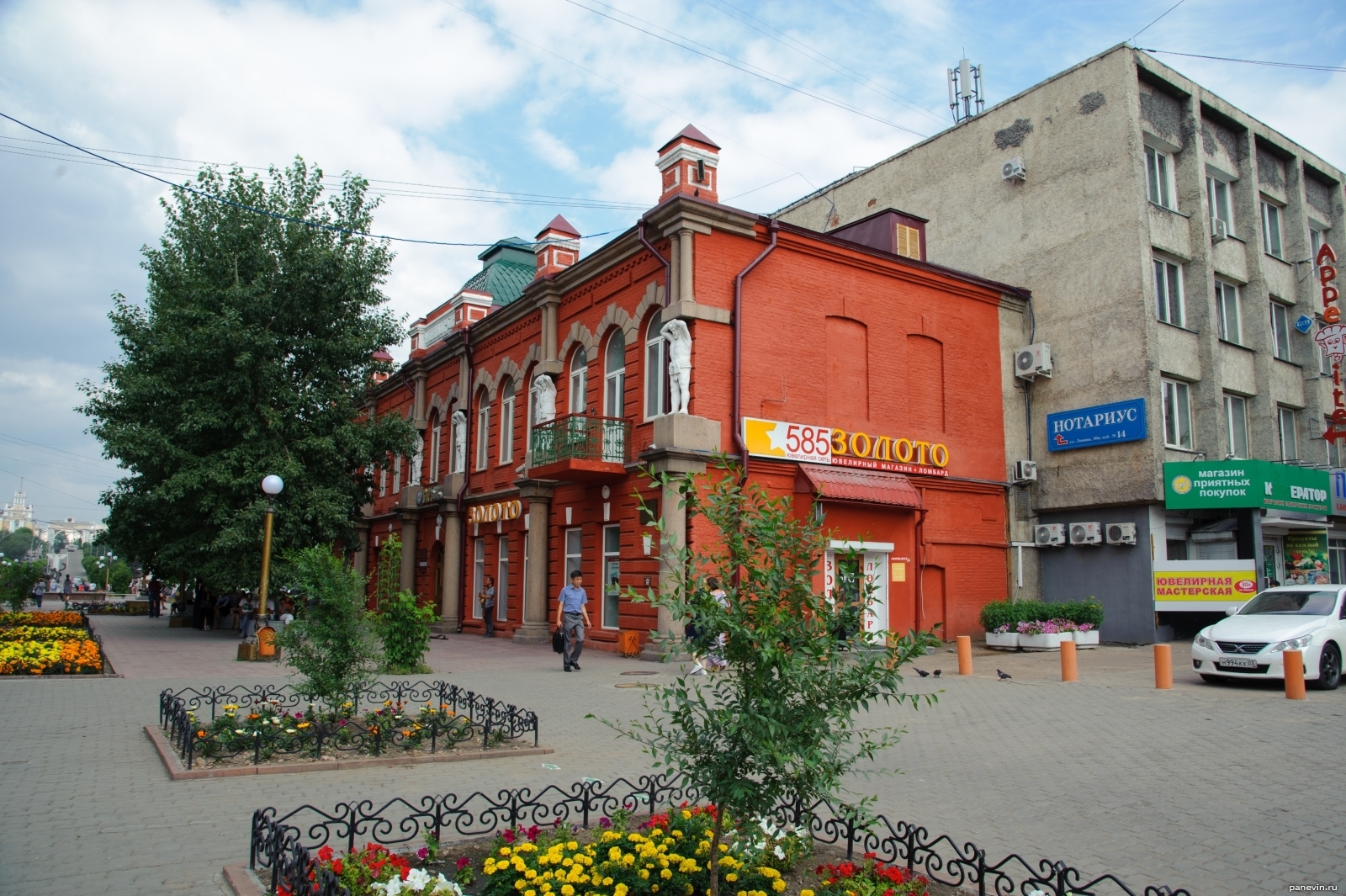
The old city nowadays
In 1934, Verkhneudinsk was renamed Ulan-Ude, which is translated from the Buryat language meaning “Red Uda”, “red river”. Merchant houses were transferred to communal property, some churches were destroyed, life changed and the historical center of the city began to deteriorate. In recent decades, the attention of tourists and the townspeople themselves has returned to the historical center. Cafes, shops, hostels and bars began to appear here. There are guided tours around the historical center. For example, guide Natalia Myasnikova offers a “Wooden Lace” tour dedicated to platbands, their structure and purpose.
In 1934, Verkhneudinsk was renamed Ulan-Ude, which is translated from the Buryat language meaning “Red Uda”, “red river”. Merchant houses were transferred to communal property, some churches were destroyed, life changed and the historical center of the city began to deteriorate. In recent decades, the attention of tourists and the townspeople themselves has returned to the historical center. Cafes, shops, hostels and bars began to appear here. There are guided tours around the historical center. For example, guide Natalia Myasnikova offers a “Wooden Lace” tour dedicated to platbands, their structure and purpose.